School Crossing Guard Struck and Killed by a Sport Utility Vehicle
New Jersey Case Report: 05NJ090
Report Date: November 13, 2006
Summary
On October 25, 2005, an 81-year-old female school crossing guard was struck by a large sport utility vehicle (SUV) after stepping into the street to stop traffic. The incident occurred on a wide, two-lane road near a suburban high school. It was a few minutes after sunrise when she walked into the southbound lane crosswalk and raised her hand-held stop sign towards the northbound traffic to cross three children waiting at the curb. It was cloudy and raining, and visibility was poor. As her back was turned to the traffic, a crossing guard for a neighboring town was driving his SUV to work. He reportedly saw the victim step off the curb, but was not able to stop in time to avoid hitting the victim, who became trapped underneath the vehicle. Witnesses called 911, and an immediate rescue effort was launched to extricate the victim. She was transported to the local hospital where she died of her injuries a few hours later. NJ FACE investigators recommend following these safety guidelines to prevent similar incidents:
- School crossing guards should be fully equipped with safety gear including retroreflective vests, raincoats, and stop signs.
- Municipalities should be aware of and follow the national Manual on Uniform Traffic Control Devices (MUTCD) standards and NJ State laws regarding school crossing guards and traffic control at schools.
- Municipalities should consider additional measures to increase visibility or slow traffic at intersections during school crossing periods.
Introduction
On October 26, 2005, NJ FACE staff received a newspaper article about a municipal adult school crossing guard who was killed after being struck by a sport utility vehicle (SUV) while at work. NJ FACE staff investigated this incident as part of a NJ FACE research project, the goal of which is to publish a warning bulletin regarding school crossing guard fatalities. A NJ FACE investigator contacted the victim’s employer on November 14, 2005, and conducted an on-site investigation on November 29, 2005. The investigating police officer was interviewed and the incident site was viewed and photographed. Additional information on the incident was obtained from the police report, the medical examiner’s report, and the Public Employees Occupational Safety and Health (PEOSH) Program inspection file. In addition, the Automobile Association of America (AAA), the local police academy, a county engineer’s office, and several other agencies were also contacted to obtain background information on adult school crossing guard procedures and safety.
The victim’s employer was a municipal police department (SIC 9221, NAICS 922120) in a New Jersey town of 2.6 square miles and 8,700 residents. The police department employed nine full-time and two part-time adult crossing guards to cover nine posts. There were no written job or safety procedures for the crossing guards. However, each guard was sent for state-mandated classroom training for crossing guards at the county police academy, with the three-hour course covering methods of traffic control and the duties and responsibilities of the guards. Guards also received supervised on-the-job training by a police officer until deemed competent to cover the post on their own. The town supported a safety committee that met quarterly with representatives from each department, including the police department who represented the crossing guards. Police department employees were unionized under a municipal employees association.
The victim was an 81-year-old white female who had worked for the township for 15 years. She had successfully completed the school crossing guard training course in August 2001. The employer stated that she worked an active post and was energetic and reliable. She was survived by her four children and four grandchildren.
Back to Top
Investigation
Under New Jersey law (NJ Statutes Title 40A:9-154), adult school crossing guards fall under the jurisdiction of the local police who are responsible for traffic control. This law states that no person can be appointed as an adult school crossing guard unless he/she meets the following requirements:
- Is a citizen and resident of this state,
- Is sound in body and of good health,
- Is of good moral character, and
- Has not been convicted of any criminal offense involving moral turpitude.
In addition, the law requires a minimum of two hours of classroom training and 20 hours of supervised on-the-job training. When hiring new guards, the employer conducted a background check, performed one-on-one interviews, and verified that the applicants were physically capable of doing the job. Once hired, the guards attended a three-hour training course at the county police academy, followed by a period of supervised on-the-job training. The employer stated that all guards were issued a reflective vest, a non-reflective bright orange rain coat, and a non-reflective hand-held stop sign. As per NJ law, the guards received a yearly appointment and must be re-appointed each year after their terms expire.
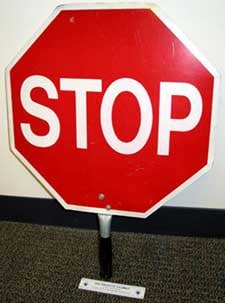
|
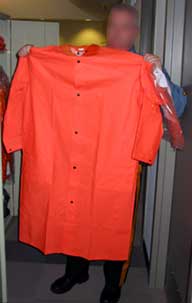
|
|
Photo 1. Stop-sign paddle used by the victim.
|
Photo 2. Raincoat identical to the one worn by the victim.
|
The town where the incident occurred supported two elementary schools (K-6th grade) and one high school (7-12th grade), with the population of the high school being 559 students. Before establishing a school crossing post, the police conduct a study to determine the pedestrian flows, traffic patterns, and sight lines. If an area is chosen, crossing lines and warning signs are installed in the area. Using this method, the police created nine crossing posts in the town. Each school crossing guard was required to report to his/her posts for the following shifts: the 7:15 to 9:00 a.m. morning shift, the 11:30 a.m. to 12:30 p.m. lunch shift, and the 2:40 to 4:00 p.m. afternoon shift. Most guards drove to their assignments and parked close to their posts. The police checked each post to insure it was occupied and provided coverage if it was not. The employer estimated that the guards crossed from 50 to 70 children during a normal morning shift.
The incident occurred on the morning of Tuesday, October 25, 2005. The weather on the morning of the incident was cloudy and raining, with a temperature of approximately 50°F. A police officer reported arriving at a neighboring school crossing post at 7:18 a.m. and activated the flashing yellow school warning signs. Sunrise for the area that morning was at 7:19 a.m., and the street lights were reportedly still lit in the cloudy dawn light. The victim’s crossing post was located approximately 200 feet south of the police officer’s post, on a straight section of street with clear lines of sight to the north and south. She had driven to the post and parked her car nearby. She was wearing her uniform for the day, which included a long orange plastic raincoat and a hand-held stop sign. There were no reports of her wearing a reflective vest.
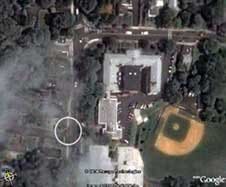
|
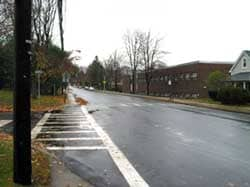
|
|
Photo 3. Satellite photo of area.
(Google Earth photo) |
Photo 4. Photo of intersection facing north.
|
At 7:24 a.m., the victim raised her stop sign and stepped into the crosswalk to help three children cross the street, possibly the first crossing of her day. Witnesses reported that she stepped into the northbound traffic lane and was facing the southbound traffic when she was struck from behind by a large SUV. The driver was a 70-year-old male adult school crossing guard for a neighboring town who was driving to his second day of work. He was driving a large, 1987 SUV with a gross vehicle weight of 6,800 pounds. A newspaper quoted him as saying, “It was raining really hard and visibility wasn’t great, and I saw her step off the curb and I slammed on the brakes, but I have a big heavy truck and it skidded. I couldn’t stop, and it went right over her.” The truck struck the victim, who landed on the hood of the SUV and then fell to the street. The SUV stopped briefly and then moved forward, running over the victim and dragging her approximately ten feet until stopping again with her trapped under the rear axle. Witnesses immediately made numerous 911 calls for help. The police arrived quickly and found the victim pinned in a sitting position under the SUV. EMS and fire units used extrication air bags to lift the vehicle and free the victim, who was taken by ambulance to the local hospital. Despite efforts to save her, she died of her injuries a few hours later, at 12:00 p.m.
The police investigation of the incident found that the SUV did not have any mechanical defects that would have contributed to the incident. The driver was cited for four violations: reckless driving, careless driving, disregard of a traffic officer directing traffic, and failure to yield to a pedestrian in a crosswalk.
Back to Top
Recommendations/Discussion
Recommendation #1: School crossing guards should be fully equipped with safety gear including retroreflective vests, raincoats, and stop signs.
Discussion: This incident occurred during a dark, rainy morning where the visibility on the road was limited. The victim was wearing a bright orange raincoat which did not have any reflective material on it, nor was her hand-held stop sign reflective, which would make it difficult for a motorist to see her. To prevent future incidents, NJ FACE recommends that police departments provide retroreflective safety gear for the crossing guards, and ensure that it is worn (retroreflective material sends light directly back to where it came from, regardless of the angle of the light source). This should include all outerwear (raincoats, jackets, and vests) and hand-held signs.
Recommendation #2: Municipalities should be aware of and follow the national Manual on Uniform Traffic Control Devices (MUTCD) standards and NJ State laws regarding school crossing guards and traffic control at schools.
Discussion: The equipment provided to and worn by the crossing guards did not meet the requirements outlined in Part 7 of the 2003 Manual on Uniform Traffic Control Devices (MUTCD), Traffic Controls for School Areas. Published by the Federal Highway Administration, the MUTCD is the national standard on traffic control on public roads. The standard requires that adult crossing guards and student patrols wear retroreflective clothing that conforms to the American National Standards Institute (ANSI) 107-1999 Class 2 for adult crossing guards, and Class 1 for student patrols. The standard also requires retroreflective or illuminated stop-sign paddles.
Part 7 of the MUTCD specifically covers traffic control in school areas, giving specific standards for signs, markings, and signals. The standard also outlines the requirements for crossing supervision, including both adult crossing guards and student patrols. The standard gives the general qualifications for adult crossing guards, and specifies general operating procedures such as the use of the stop-sign paddle for adult guards and flagging devices for student patrols. The MUTCD may be downloaded for free at the Internet Web site http://mutcd.fhwa.dot.govexternal icon.
Municipalities must also be aware of NJ laws regarding crossing guards. New Jersey Statute Title 40A:9-154 specifies the legal requirements for appointing, qualifications, training, and uniforms for adult school crossing guards. These requirements include placing the guards under the jurisdiction of the police and ensuring the guards are capable and of good moral character. Adult crossing guards are also required to receive a minimum of two hours of classroom and 20 hours of field training, and be provided with distinctive uniforms and safety vests.
Recommendation #3: Municipalities should consider additional measures to increase visibility or slow traffic at intersections during school crossing periods.
Discussion: This incident occurred early in the morning during poor weather, limiting the visibility of the drivers. Although the MUTDC standards are comprehensive in setting up school crossings, it may be helpful to consider additional measures to increase visibility and/or slow down traffic approaching crossing guard posts. A recently developed device is an in-road lighting system, which uses permanent in-road warning lights along the borders of the crosswalk. The flashing lights could be used whenever the crossing guard is on duty, or activated by the crossing guard during each individual crossing. Traffic speed may also be limited by installing speed bumps or humps near the posts. This may be especially useful in residential streets where slower speed limits are posted. The use of radar speed-indicating boards may also help drivers to slow down by alerting them of their speed. NJ FACE also encourages municipalities to keep records of infractions, violations, and “near-misses” at school crossing posts. Using these records to monitor traffic problems would be helpful in designing traffic controls to prevent injuries to guards and children.
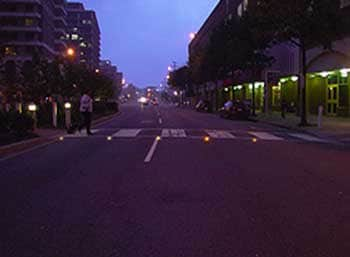
|
|
Photo 5. Example of in-road lighting system.
(USDOT Web site Photo) |
Recommended Resources
It is extremely important that employers obtain accurate information on health, safety, and applicable OSHA standards. NJ FACE recommends the following sources of information which should help both employers and employees:
U.S. Department of Labor, Occupational Safety & Health Administration (OSHA)
Federal OSHA will provide information on safety and health standards on request. OSHA has four area offices in New Jersey that cover the following counties:
Hunterdon, Middlesex, Somerset, Union, and Warren counties
Telephone: (732) 750-3270
Essex, Hudson, Morris, and Sussex counties
Telephone: (973) 263-1003
Bergen and Passaic counties
Telephone: (201) 288-1700
Atlantic, Burlington, Cape May, Camden, Cumberland, Gloucester, Mercer, Monmouth, Ocean, and Salem counties
Telephone: (856) 757-5181
Federal OSHA
Web site: https://www.osha.gov/external icon
New Jersey Public Employees Occupational Safety and Health (PEOSH) Program
The PEOSH Act covers all NJ state, county, and municipal employees. Two state departments administer the act; the NJ Department of Labor and Workforce Development (NJDLWD), which investigates safety hazards, and the NJ Department of Health and Senior Services (NJDHSS) which investigates health hazards. PEOSH has information available that may also benefit private employers.
NJDLWD, Office of Public Employees Safety
Telephone: (609) 633-3896
Web site: http://lwd.dol.state.nj.us/lsse/employer/Public_Employees_OSH.htmlexternal icon (Link updated 3/26/2013)
NJDHSS, Public Employees Occupational Safety & Health Program
Telephone: (609) 984-1863
Web site: http://www.state.nj.us/health/eoh/peoshweb/external icon
New Jersey Department of Labor and Workforce Development, Occupational Safety and Health On-Site Consultation Program
This program provides free advice to private businesses on improving safety and health in the workplace and complying with OSHA standards.
Telephone: (609) 984-0785
Web site: http://lwd.dol.state.nj.us/labor/lsse/employer/Occupational_Safety_
and_Health_Onsite_Consultation_Program.htmlexternal icon (Link updated 3/26/2009)
New Jersey State Safety Council
The NJ State Safety Council provides a variety of courses on work-related safety. There is a charge for the seminars.
Telephone: (908) 272-7712.
Web site: http://www.njsafety.orgexternal icon
Internet Resources
Other useful internet sites for occupational safety and health information:
- CDC/NIOSH – https://www.cdc.gov/niosh/
- Employment Laws Assistance for Workers and Small Businesses – http://www.dol.gov/elaws/external icon
- National Safety Council – http://www.nsc.org/Pages/Home.aspxexternal icon (Link updated 11/17/2009)
- American National Standards Institute (ANSI) – http://www.ansi.orgexternal icon
- Product recall information – http://www.recalls.govexternal icon
- NJDHSS FACE reports – http://www.state.nj.us/health/eoh/survweb/face.htmexternal icon
- CDC/NIOSH FACE – https://www.cdc.gov/niosh/face/
References
- Manual on Uniform Traffic Control Devices for Streets and Highways, 2003 Edition. U.S. Department of Transportation, Federal Highway Administration, 400 Seventh Street, SW
Washington, DC 20590, Web site: http://mutcd.fhwa.dot.govexternal icon. - Safe Crossings: Adult School Crossing Guard Training Program. Automobile Association of America, Mid-Atlantic Foundation for Safety & Education, 2040 Market Street, Philadelphia, PA 19103, Web site: http://www.aaa.com/safety (Link no longer valid)
New Jersey FACE Program
Fatality Assessment and Control Evaluation (FACE) Project
Investigation # 05-NJ-090
Staff members of the New Jersey Department of Health and Senior Services, Occupational Health Service, perform FACE investigations when there is a report of a targeted work-related fatal injury. The goal of FACE is to prevent fatal work injuries by studying the work environment, the worker, the task and tools the worker was using, the energy exchange resulting in the fatal injury, and the role of management in controlling how these factors interact. FACE gathers information from multiple sources that may include interviews of employers, workers, and other investigators; examination of the fatality site and related equipment; and reviewing OSHA, police, and medical examiner reports, employer safety procedures, and training plans. The FACE program does not determine fault or place blame on employers or individual workers. Findings are summarized in narrative investigation reports that include recommendations for preventing similar events. All names and other identifiers are removed from FACE reports and other data to protect the confidentiality of those who participate in the program.
Please visit the NJ FACE Web site at http://www.state.nj.us/health/eoh/survweb/face.htmexternal icon or the CDC/NIOSH FACE Web site at https://www.cdc.gov/niosh/face/ for more information.
This NJ FACE report is supported by Cooperative Agreement # 3-U60-OH008485 from the Centers for Disease Control and Prevention (CDC). Its contents are solely the responsibility of the authors and do not necessarily represent the official views of the CDC.
To contact New Jersey State FACE program personnel regarding State-based FACE reports, please use information listed on the Contact Sheet on the NIOSH FACE web site. Please contact In-house FACE program personnel regarding In-house FACE reports and to gain assistance when State-FACE program personnel cannot be reached.

